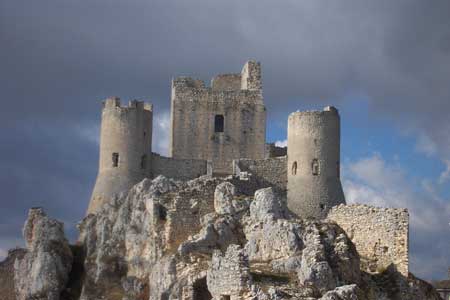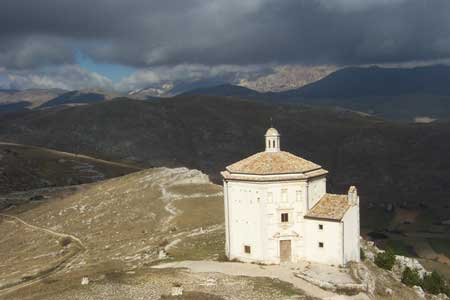1000 Years of Rocca Calascio

As we circled up into the mountains of Abruzzo the air thinned and the November sun streamed unabated through the passes and over the rock laid bare by passing time and the elements. Occasional villages of damp stone homes with tile roofs clung miserably to hillsides; along the valley floors tight flocks of sheep tracked sheperds to corrals unseen. The mountains' sense of permance made even more ephemeral all that was human in the region: humankind seemed a burden the mountains would bear grudgingly while never actually succumbing to the intrusion. In a world where modern society had made little progress since the Middle Ages, my clock ran backwards like an inverse altimeter, taking me back to a simpler time.
As we circled up into the mountains of Abruzzo the air thinned and the November sun streamed unabated through the passes and over the rock laid bare by passing time and the elements. Occasional villages of damp stone homes with tile roofs clung miserably to hillsides; along the valley floors tight flocks of sheep tracked sheperds to corrals unseen. The mountains' sense of permance made even more ephemeral all that was human in the region: humankind seemed a burden the mountains would bear grudgingly while never actually succumbing to the intrusion. In a world where modern society had made little progress since the Middle Ages, my clock ran backwards like an inverse altimeter, taking me back to a simpler time.
On all sides the Appennines reached upwards in sterile tranquility. The low, stiff grass that skinned the rock in places where the thin sun reached grew more sparse and rock jutted up like ossified molars in an Appennine jawbone. Our trail, forded since prehistory on foot and horseback, led us upward, thinned, deteriorated,and finally faltered at the foot of Rocca Calascio, a medieval castle that has looked over the valleys since the 10th century. The castle's craftsmen built it on a promontory that provided 360 degree views of the surrounding mountain valleys, the castle's principal advantage even in 2006. Stout and square, the tower had been no more than a watch post for five hundred years, when it was fortified to meet the growing threat of attack. Four circular towers formed the thick corners, broad at the base and then narrowing into a waistline before rising up to a series of slits for crossbow sights. From the stronghold at the center, the original tower continued for another 20 feet over the lower ramparts. We reached the tower's wall by traversing wooden planks that led over a narrow gorge cut deep into the rock, a treacherous final obstacle for more than one band of roving Visigoths.
No similar danger, unseen, unexpected, and capable of inflicting horrid physical harm, exits today. But it was easier to envision the fear of what awaits you when the last torch flickers and expires in a midmorning when not even the wind was blowing, and the thick grove of dark pines that huddled in a crook of the peak's treacherous flanks stood motionless in the wan November light. We climbed the rocks around the castle, looking out over a mountain valley little changed since the days the castle was built: tough hillsides that flowed violently one over the other until they swelled into the granite peaks that made the whole area so impenetrable to this day.

The sun gathered naturally on the walls of the sole improvement the mountain had experienced after the construction of the fortress, an octagonal church with tiled roof that remains a refuge for those who would commune with God in solitude and austerity. On all eight sides, all that separated supplicant from Creator was the sky.
While we traipsed around the hillside, dark clouds poured in from the west, filling and then obscuring the valley and rushing up the hillside towards us. We found refuge in an osteria beneath the castle walls, where we lunched on dishes unchanged throughout human history: mushrooms, wild berries, sausage, and red wine and cheese. The storm passed by the time we were enjoying espresso, and the sleet collected at trail-side we made our way back down the mountain on a road that led us from the Middle Ages back to the 21st century.
It's hard to fathom the little octagonal church has remained at the shoulder of that immense hill for over 500 years of human existence; harder still to comprehend the castle was already 500 years old when the church's first stones were placed. But humankind occupied those hard, inhospitable valleys for at least 1000 more years before then. Very little distinguishes me from those early denizens physically, while intellectually my understanding of the world would be nearly incomprehensible to those who travelled to that little octagonal church to pray or who sought refuge within the castle walls. Gone is the darkness of the Middle Ages, and science, medicine, and philosophy tell me more about the meaning of life than does religion.
Looking out over the valley from Rocca Calascio it's easy to think over the course of a millennium nothing has changed, harder to wonder how much more we'll understand if we as a species manage to sustain ourselves on this narrow precarious earth another thousand years. The threats we face are less bands of roving Visigoths or Mongols and more the world we have made: genetic modification, monocropping, forced abortions, and nuclear weapons, not to mention religious intolerance and political ambition. Should we overcome ourselves the world my children inhabit will be even more beautiful as seen from Rocca Calascio. To the contrary we may look back on the 10th century with envy.
Trackbacks
The author does not allow comments to this entry

Comments
Display comments as Linear | Threaded